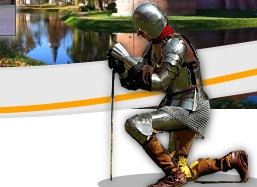| The first earth and timber fort was raised
here by the Teutonic knights in the mid-13th century. It stood
in the fork between the Drwęca river branches, replacing an
earlier Prussian stronghold. Construction of a brick castle
built on a stone foundation was started by the Ostróda Commnader
(Hauskomtur) around 1349. The old earth and timber fortress
together with the unfinished brick castle were hit by a fire
during a Lithuanian raid commanded by duke Kiejstut in 1381.
Soon afterwards a new brick castle was built.
The convent castle was constructed on a square plan, 44.7
x 45.2 m externally. Originally it had four wings with an
archway in the west wing. Recently, the castle has been restored
in the shape it had after the fire in 1788. Three wings (south,
wet and north) have been preserved, although they lack the
topmost storey, which was used for defense and storage. Some
researchers claim that the castle had a tower in the south-east
corner. To the north, there was a sanitary tower, most probably
connected with the north wing of the castle by a wooden walk.
During the archeological excavations at the castle, the bases
of pillars were unearthed, which may have supported the wooden
gallery leading to the sanitary tower.
The south wing contained a chapel, the commander's quarters
and a refectory. The remaining wings most probably held the
chapter room, infirmary and dormitories for brother knights
and guests. The communication within the castle was through
wooden walks parallel to the internal sides of the walls.
Rooms on the ground floor in the north and south wings have
preserved original cross and ribbed vaults on arches supported
by granite pillars (partly reconstructed), while the cellars
underneath are topped with cross vaults on diagonal arches.
After the battle of Tannenberg, for two months Ostróda castle
remained in the hands of Duke of Masovia, Janusz Mazowicki,
who received the castle from the Polish King Władysław Jagiełło.
In September 1410 the castle returned to the Teutonic Knights.
In 1629 the Swedish King, Gustav Adolph resided at Ostróda
castle. For six years, from 1633 to 1639, the castle was ruled
by the Silesian Duke of Legnica and Brzeg, John Christian.
In the great fire of Ostróda in 1788, the flames reached the
castle, where large quantities of gunpowder were stored in
the east wing at that time. Soon a gigantic explosion damaged
the east wing and the castle roofs. Although the castle was
rebuilt, it did not regain its previous shape - the east wing
was not reconstructed and the whole castle was one storey
lower. In the 19th century the walls were plastered and many
extensions were added to the castle building.
From 21st February to 1st April 1807 the castle hosted the
French emperor, Napoleon Bonaparte. He arrived here to rest
after the exhausting battle at Prussian Eylau, which was victorious
for the French party but caused much bloodshed. A rather unexpected
outcome of that brief stay at Ostróda castle was a number
of arts objects documenting the event. The Ostróda Museum
exhibits a replica of the painting by the French artist Marie
Nicolas Ponce-Camus 'Napoleon promises his grace to Ostróda
burgers. March 1807'; the original canvas hangs in the historic
gallery at Versailles. Another exhibit at Ostróda Castle which
commemorates Napoleon I is a silver medal 'Napoleon a Osterode',
made by the French graver Bertrand Andrieu.
In the 19th century the castle was a seat for the local administration
office and court of justice. There were also several apartments
for officials. In 1945 the castle was burnt by the Soviet
Army and remained in the state of preserved ruin for nearly
thirty years. The reconstruction of the castle was commenced
in 1974 and continued until the 1990s. At present, the castle
houses the Museum of Ostróda, the Centre of Culture, a gallery
and a library.
Museum in Ostróda
ul. Adama Mickiewicza 22, 14-100 Ostróda, Poland
tel./fax 089 646 26 02, e-mail: muzeum.w.ostrodzie@neostrada.pl
|






![]()
![]() The
project is co-financed from the funds of the European Regional Development Fund,
under the framework of the Lithuania,
The
project is co-financed from the funds of the European Regional Development Fund,
under the framework of the Lithuania,